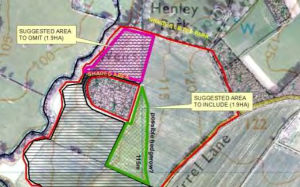Update: 25 June 2015
Kronos have submitted a second revised plan. The initial plan was revised after Historic England and Shropshire Council’s heritage team raised concerns about how well the impact of the arrays on Henley Hall had been assessed (see below). That revision moved part of the array from beyond Colonel’s Plantation near Henley Hall up the slope to join the main array area. Now these plans have been dropped and the array area has been reduced in size. As yet the supporting documents have not been updated, so we don’t know how much energy this smaller solar farm will generate.

Ludlow Town Council have written a strongly worded objection against the proposal.
Original Post: 11 June 2015
Last week, Historic England and Shropshire Council’s historic environment team criticised the heritage environment assessment for proposed the Henley Hall solar farm (15/01472/FUL). They said the report is not thorough enough to allow them to examine the effect the scheme will have on heritage assets such as Henley Hall.
Now the authors of that report have hit back saying the report does indeed meet national requirements for such assessments. And, somewhat surprisingly, they have published a new layout for the scheme.
Writing on behalf of AC archaeology, director Peter Cox says:
I consider that the submitted historic environment assessment provides a proportionate and appropriate level of assessment given the potential (indirect) impacts. The assessment has addressed the significance of the designated assets which could be affected.
These designated heritage assets are Henley Hall, its gardens and Park House. Historic England and Shropshire Council had said that the historic environment assessment is “lacking in an understanding of the relationship both historic and present with the surrounding landscape.” Peter Cox responds:
Our research found no evidence to suggest that the historic park was designed with deliberate external views or links to other designed landscapes, nor that its design incorporated any remote ‘eye-catching’ features or ‘borrowed’ landmarks beyond the park boundary. The park, with trees, hedges and banks clearly demarcating its boundaries, has been designed to be at variance to the surrounding agricultural landscape rather than complimentary to it. I consider that the setting of the assets within the park comprises this aesthetically designed landscape, deliberately detached from the working agricultural landscape beyond.
He continues:
While I consider that there would be an indirect impact on [Henley Hall] Registered Park, I strongly disagree with the assertion that a relatively small solar farm within the agricultural landscape around the park, which includes many hundreds of hectares, can be considered to comprise industrialisation of its setting. In this respect it should be noted that such visual impacts as may exist are fully reversible and do not comprise permanent physical impacts.
No one would be surprised that an expert company will defend a report it has produced. Mr Cox goes one step further. He says:
In response to the concerns of HE and the Shropshire Council Archaeological Officer, the applicant has agreed to adjusting the scheme layout such that there is a clear belt of agricultural land retained between the Registered Park boundary and The Colonel’s Plantation; a copy of the plan is attached. I consider this would provide a more acceptable scheme to your heritage consultees.
His report contains a new plan of the scheme. It moves part of the solar array from adjacent to Henley Park up the slope to expand the main area of the array.


